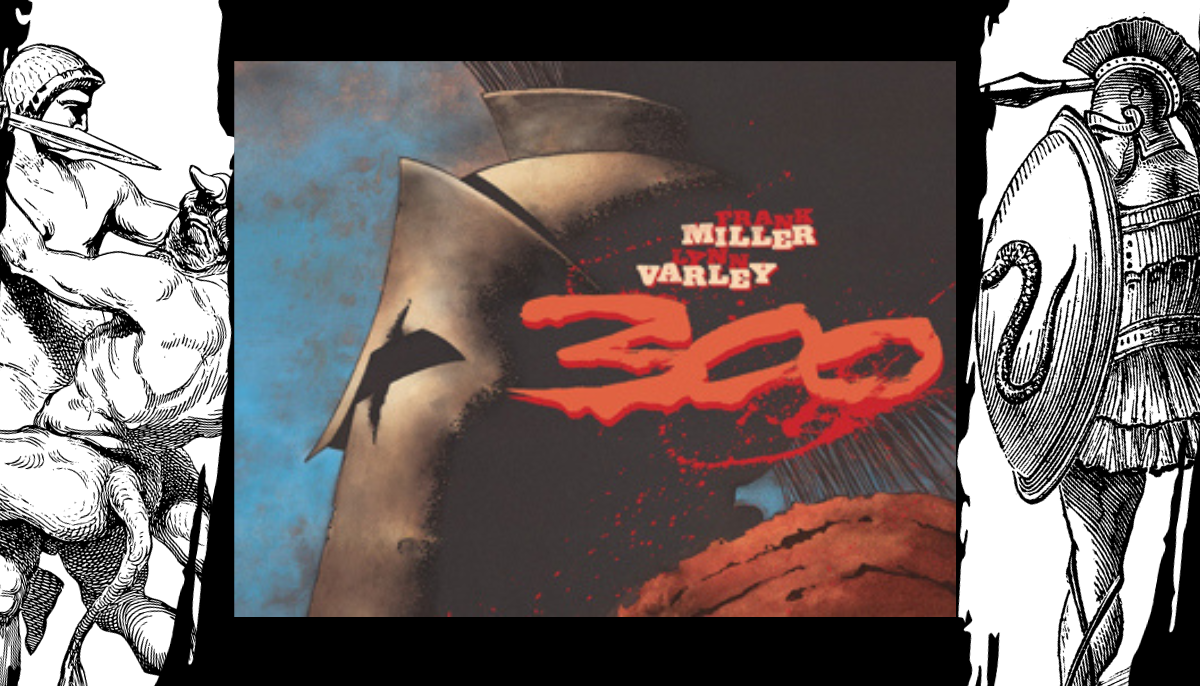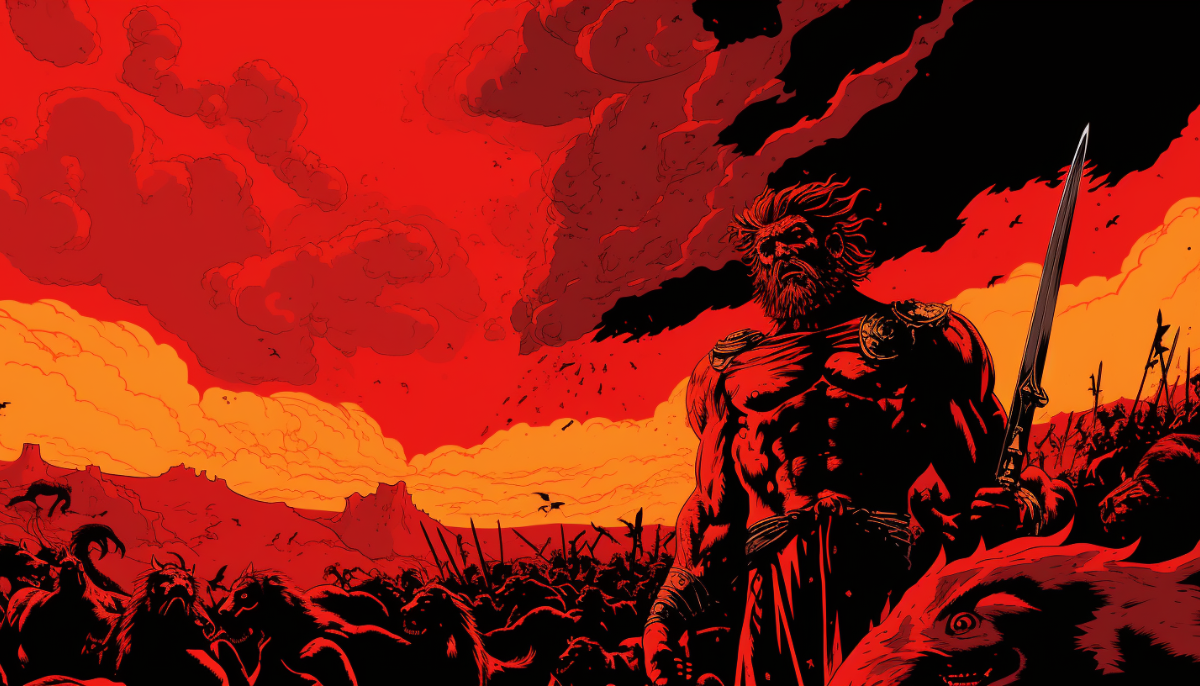Welcome to the best Greek mythology graphic novels, which blend ancient tales and modern artistry. With its pantheon of gods, epic heroes, and timeless tales, Greek mythology has been a source of fascination for centuries.
Whether you’re a long-time fan of Greek mythology or discovering its wonders, these graphic novels offer a fresh and exciting perspective on these classic stories.
Our top pick, an exceptional work that stands out for its artistry and narrative, is highlighted at the beginning of the article. Join us as we journey through ancient tales reimagined in the vibrant and dynamic medium of graphic novels.
This article is one in a series on the best Greek mythology books.
the best Greek mythology graphic novel – 300, Frank Miller & Lynn Varley

“300” by Frank Miller is our top choice for graphic novels based on Greek mythology, appealing to both seasoned fans of graphic novels and Greek myth enthusiasts, as well as newcomers to either genre.
This graphic novel, set in 480 BCE, vividly recounts the legendary stand of King Leonidas of Sparta and his 300 warriors against the massive Persian army led by Xerxes at the Battle of Thermopylae. Miller’s storytelling is dramatic and engaging, perfectly capturing this historical event’s heroic and tragic essence.
The art in “300” is particularly noteworthy. Miller’s gritty yet beautiful style, characterized by its use of stark, contrasting colors – notably the brownish tones with shocks of bright red – creates an impactful visual narrative. His innovative approach has influenced many subsequent works, but “300” stands out for its originality and striking imagery.
The minimal yet powerful dialogue complements the storytelling, allowing the art to convey much of the narrative’s emotional and dramatic weight.
Frank Miller’s “300” is more than just a graphic novel; it’s a masterclass in comics artistry. The book’s cinematic quality is so compelling that many of its scenes and lines were directly adapted into the famous film adaptation. Miller’s work and Lynn Varley’s exceptional color work make every page a visual feast.
It is a must-read, not just for fans of comics or Greek mythology but for anyone who appreciates powerful storytelling and stunning visual artistry.
A Thousand Ships – Age of Bronze, Eric Shanower

“A Thousand Ships,” part of the “Age of Bronze” series, is an exceptional graphic novel that delves into the epic story of the Trojan War. This novel stands out for its detailed and gripping portrayal of one of the most famous wars in Greek mythology.
The story begins with the abduction of Queen Helen of Sparta by the Trojan Prince, which sparks the legendary Trojan War. The narrative unfolds with the assembly of a massive Greek force led by High King Agamemnon, determined to reclaim Helen. This conflict brings together some of the most renowned figures in Greek mythology, including Achilles, Odysseus, and Herakles, each with their complex backgrounds and motivations.
The artwork in this series is notable for its attention to detail and ability to bring the ancient world to life. The visual storytelling complements the rich narrative, enhancing the reader’s experience of this timeless tale.
“A Thousand Ships” has gained recognition for its quality, evidenced by its inclusion in major international exhibitions and nominations for numerous Eisner Awards.
Bacchus, Eddie Campbell

“Bacchus, Vol. 1: Immortality Isn’t Forever” by Eddie Campbell is a graphic novel that offers a unique and compelling take on Greek mythology. This volume introduces Bacchus, the 4,000-year-old Greek God of Wine, alongside other intriguing figures like Joe Theseus and the Eyeball Kid.
Eddie Campbell’s work in this novel has been praised for its artistic brilliance, combining rich scenes with complex pattern work and gritty character design. His approach to storytelling in “Bacchus” is noted for its depth and originality, breathing new life into well-trodden mythological themes. The narrative explores the lives of the Greek gods in a modern setting, revealing their flaws, ambitions, and surprisingly sympathetic natures.
The story of “Bacchus” delves into what happens to the Greek gods over time, portraying them as distant and difficult immortals who become more relatable and human-like as the tale unfolds. Campbell’s skill in character development shines through, making the gods feel fresh and relevant in a contemporary context.
The Odyssey, Gareth Hinds

The Odyssey: A Graphic Novel by Gareth Hinds is a remarkable adaptation of Homer’s epic, “The Odyssey,” praised for its artistic interpretation and storytelling.
Gareth Hinds’ rendition of this ancient classic is acclaimed for its bold and vivid imagery, which brings the epic poem to life in a new and exciting way. Rick Riordan, author of the Percy Jackson series, lauds it as a “worthy new interpretation of Homer’s epic,” highlighting its blend of art and storytelling.
The graphic novel follows Odysseus, King of Ithaca, through his perilous journey home after the Trojan War. Defying the sea god Poseidon, Odysseus faces a series of daunting challenges, including encounters with man-eating monsters, violent storms, and enchanting sirens and sorceresses. His tale is one of heroism and cunning, requiring divine intervention and sheer will to overcome the odds.
The visual storytelling effectively depicts the various mythical elements of the story, such as the sirens, Scylla and Charybdis, the Cyclops, and the underworld journey. While the illustrations occasionally lean towards traditional comic book styles with exaggerated physical features, they fit the epic’s heroic and adventurous nature.
The graphic novel format suits “The Odyssey” exceptionally well, as it’s a story rich in visual elements. Hinds’ adaptation is appreciated for its faithfulness to the original epic while bringing a fresh and dynamic perspective.
Zeus – Olympians, George O’Connor

Zeus: King of the Gods – This graphic novel is the first in O’Connor’s Olympians series and sets a high standard for storytelling and art. It begins with the genesis of the Greek pantheon, focusing on Zeus’s early life, his struggle against his father, Kronos, and his battle with the Titans. The story provides a detailed and captivating account of how Zeus obtained his lightning bolt, a symbol of his power and authority.
The artwork in “Zeus: King of the Gods” is highly praised. The illustrations are described as dynamic and powerful, with the use of lightning and other elements bringing the story to life on the page. The art style, reminiscent of acclaimed artists like P. Craig Russell and Barry Windsor-Smith, adds depth and excitement to the narrative.
As a young adult graphic novel, it strikes a balance between being accessible to younger readers and engaging for adults.
Kill the Minotaur, Chris Pasetto & Christian Cantamessa

Kill the Minotaur #1 – This graphic novel reimagines a classic Greek myth with a modern, horror-infused twist. The story revolves around the myth of the Minotaur, the monstrous half-man, half-bull creature that dwells in the labyrinth of Crete, adding layers of suspense and terror to the ancient tale.
The narrative focuses on Theseus, the legendary hero of Greek mythology, and his journey into the labyrinth to confront the Minotaur. However, in this adaptation, the story is expanded and given a darker, more atmospheric feel, making it appealing to both fans of Greek mythology and horror genres.
The artwork in “Kill the Minotaur” is notable for its ability to create a claustrophobic and eerie mood, with detailed illustrations that bring the labyrinth and its monstrous inhabitant to life. The visual storytelling enhances the sense of dread and suspense, making the reader feel like they are journeying alongside Theseus.
The Ring of Nibelung – The Ring Cycle, P. Craig Russell

The Ring of the Nibelung #1-4 – This graphic novel series by P. Craig Russell, translated by Patrick Q. Mason and coloring by Lovern Kindzierski, brings a legendary story to life through comics. Rated highly for its artistic and narrative quality, the series presents a powerful adaptation of one of the most significant stories in Western culture.
The epic tale is rooted in mythology and opera, involving gods, giants, and human lovers. It’s a saga filled with intrigue, betrayal, and tragedy revolving around themes of love, power, and greed. The graphic novel format allows these themes to be explored in a visually striking and accessible way.
Russell’s adaptation stands out for its fidelity to the original opera while breathing new life into it as a high-fantasy saga. His artistic style, known for its elegance and expressiveness, perfectly captures the dramatic and mythic elements of the story. The added behind-the-scenes content and notes on the adaptation further enrich the reading experience, offering insights into the creative process.
Neil Gaiman’s praise of the series underscores its quality and impact. For fans of Greek mythology and epic storytelling, “The Ring of the Nibelung” offers a different mythological perspective steeped in rich narrative and artistic tradition. It’s a series that respects its source material and transforms it into an engaging and visually stunning graphic novel experience.
Greek Street, Peter Milligan

Greek Street, Volume 1 – This graphic novel, penned by Peter Milligan with artwork by Davide Gianfelice, offers a unique and modern twist on classic Greek mythology. Set in contemporary London, it reimagines these ancient tales in a gritty, urban context, making it a compelling read for those fascinated by Greek myths.
The story interweaves various characters and plotlines from Greek mythology but recontextualizes them in the modern world. For instance, characters and stories inspired by figures like Oedipus and Orpheus are given a contemporary makeover. This approach makes the myths more relatable to a modern audience and explores timeless themes like fate, power, and identity in fresh, thought-provoking ways.
The artwork in “Greek Street, Volume 1” complements its dark and edgy narrative, with Gianfelice’s visuals capturing the gritty atmosphere of London’s underworld. The graphic novel’s bold narrative style and modernized mythology make it an intriguing choice for readers who enjoy seeing ancient myths reinterpreted in new settings.
Promethea, Alan Moore

Promethea, Vol. 1 – Written by Alan Moore and illustrated by J.H. Williams III, “Promethea” is a graphic novel deeply rooted in mythology and symbolism, making it a fascinating read for fans of Greek mythology. This series stands out for its imaginative integration of mythological themes into a modern, urban fantasy setting.
The story centers around Sophie Bangs, a college student who becomes the latest incarnation of Promethea, a mythical figure who exists both in the realm of ideas and the real world. The narrative delves into themes like the nature of stories, the power of imagination, and the intertwining of myth and reality.
What makes “Promethea” particularly appealing to Greek mythology enthusiasts is its rich, layered storytelling and how it draws from various mythological traditions to create a unique and compelling world. The artwork in this series is exceptional, with Williams III’s innovative layouts and vibrant use of color adding depth and intrigue to Moore’s complex narrative.
Hellboy, Mike Mignola & John Byrne

Hellboy, Vol. 1: Seed of Destruction – This graphic novel, created by Mike Mignola, is an excellent choice for fans of Greek mythology, albeit with a unique twist.
While it doesn’t directly retell Greek myths, it masterfully incorporates elements of mythology and folklore into its narrative. Hellboy is a compelling character, a demon brought to Earth as a baby and raised by humans, straddling the line between the supernatural and the human world.
The artwork in this volume is renowned for its stark, shadow-heavy style, which creates a moody and atmospheric setting that is perfect for the mythological and supernatural themes of the story. The narrative skillfully blends action, mystery, and horror elements, making it an engaging read.
For lovers of Greek mythology, “Hellboy, Vol. 1” offers a fresh take on the classic themes of destiny, monsters, and the struggle between good and evil. Its exploration of these themes, coupled with Mignola’s unique artistic vision, makes it a standout addition to the genre of graphic novels drawing on mythological sources.






